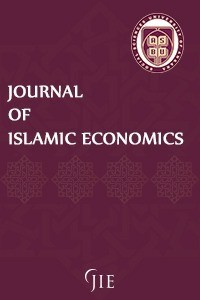The Islamic Economic System From a Normative Point of View Design Based on Questionnaire Tool
Islamic Economic System, Islamic Economic System, Conventional Economic Systems, Alternative, Normative Economics Approach
The Islamic Economic System From a Normative Point of View Design Based on Questionnaire Tool
Islamic Economic System, Conventional Economic Systems, Alternative, Normative Economics Approach,
___
- Abdo, I. (1974). Islamic economics introduction and methods. Faculty of Sharia and Law, Al-Azhar University.
- Adwan, M. (2007). The Bait Al-Mal Foundation in the early days of Islam (1—132 A.H.). An-Najah National University.
- Al-Abdali, A. (2005). E-commerce in Islamic countries (Reality—Challenges—Hopes). 1–77.
- Al-Hiti, A. R. (1998). Islamic banks between theory and practice. Dar Osama for Publishing and Distribution.
- Ali, S. S. (Ed.). (2019). Towards a Maqāṣid al-Sharīʿah Index of Socio-Economic Development: Theory and Application. Springer International Publishing. https://doi.org/10.1007/978-3-030-12793-0
- Al-Masry, R. (2012). The origins of Islamic economics. Dar Al-Qalam.
- Al-Nabhani, T. al-Din. (2004). The economic system in Islam. Dar Al Ummah for printing, publishing, and distribution.
- Al-Saati, A. R. (2011). The methodology of the modern (Quranic) Islamic economy and its features. King Abdulaziz University Journal: Islamic Economics, 58–92.
- Al-Saati, A. R. (2013). Diagnosis of the systematic crisis of Islamic economics. King Abdulaziz University Journal: Islamic Economics, 03–40.
- Al-Suyuti, R. H. (2005). The position of Islamic law on banks, banking transactions, and their alternative, self and money insurance. Dar Al-Salam for printing, publishing, distribution, and translation.
- Al-Tariqi, A. (2009). Islamic economics foundations, principles, and objectives. Jeraisy Corporation for Distribution and Advertising.
- Al-Zarka, M. (2008). The duality of knowledge sources in Islamic economics. 29–44.
- Baqir al-Sadr, M. (1987). Our economy. Dar Al Ta’rif Publications.
- BEN DAAS, Z., & AOUISSI, A. (2017). Islamic finance formulas between reality and hope. Journal of Development and Applied Economics, 2(2), 243–259.
- Caplin, A., & Schotter, A. (Eds.). (2008). The Foundations of Positive and Normative Economics: A Handbook A Handbook (1st edition). Oxford University Press.
- Choudhury, M. A. (1986). Contributions to Islamic Economic Theory. Palgrave Macmillan UK. https://doi.org/10.1007/978-1-349-07728-1
- Choudhury, M. A. (1999). Comparative Economic Theory Occidental and Islamic Perspectives. Springer US. https://doi.org/10.1007/978-1-4757-4814-7
- correspondent, R. N. W. (2017, November 14). Richest 1% own half the world’s wealth, study finds. The Guardian. https://www.theguardian.com/inequality/2017/nov/14/worlds-richest-wealth-credit-suisse
- Doyle, E. (2005). The Economic System (1st edition). Wiley.
- Ghazanfar, S. M., & Lowry, S. T. (2004). Medieval Islamic Economic Thought: Filling the Great Gap in European Economics. http://public.ebookcentral.proquest.com/choice/publicfullrecord.aspx?p=182449
- Ghlamallah, E., Alexakis, C., Dowling, M., & Piepenbrink, A. (2021). The topics of Islamic economics and finance research. International Review of Economics & Finance, 75, 145–160. https://doi.org/10.1016/j.iref.2021.04.006
- Gray, A. (2017, January 16). 8 men own the same wealth as the poorest half of the world. World Economic Forum. https://www.weforum.org/agenda/2017/01/8-men-own-the-same-wealth-as-the-poorest-half-of-the-world/
- Gregory, P., & Stewart, R. (1994). Comparative Economic Systems. Dar Al-Marikh Publishing House.
- ibis. (2015). Islamic Banks and Financial Institutions Information. Islamic Development Bank. http://www.ibisonline.net/Islamic_Banks/IndustryHighlights.aspx
- Islahi, A. A. (2014). History of Islamic economic thought: Contributions of Muslim scholars to economic thought and analysis. Edward Elgar.
- Jomo, K. S. (Ed.). (1992). Islamic Economic Alternatives. Palgrave Macmillan UK. https://doi.org/10.1007/978-1-349-12287-5
- Kahf, M. (dt). Islamic economics is a science and a system. dn.
- Kuran, T. (1992). The Economic System in Contemporary Islamic Thought. In K. S. Jomo (Ed.), Islamic Economic Alternatives (pp. 9–47). Palgrave Macmillan UK. https://doi.org/10.1007/978-1-349-12287-5_2
- Kutb, M. (1988). The financial policy of the Messenger. The Egyptian General Book Organization.
- LAJUGIE, J. (1969). Les systèmes économiques. Presses Universitaires de France.
- Marangos, J. (2013). Consistency and Viability of Islamic Economic Systems and the Transition Process. Palgrave Macmillan US. https://doi.org/10.1057/9781137327260
- Mirakhor, A., & Askari, H. (2017). Ideal Islamic Economy. Palgrave Macmillan US. https://doi.org/10.1057/978-1-137-53727-0
- Mustafa, D. A., Abdulsalam, H. A., & Yusuf, J. B. (2016). Islamic Economics and the Relevance of Al-Qawā‘id Al-Fiqhiyyah. SAGE Open, 6(4), 215824401667137. https://doi.org/10.1177/2158244016671374
- Naqvi, S. H. N., Beg, H. U., Ahmed, R., & Nazeer, M. M. (1992). Principles of Islamic Economic Reform. In K. S. Jomo (Ed.), Islamic Economic Alternatives (pp. 153–187). Palgrave Macmillan UK. https://doi.org/10.1007/978-1-349-12287-5_9
- Nassar, A. (2010). Principles of Islamic economics. Dar Al-Nafais for distribution and publishing.
- Philipp, T. (1990). The Idea of Islamic Economics. Die Welt Des Islams, 30(1/4), 117. https://doi.org/10.2307/1571048
- Pryor, F. L. (1985). The islamic economic system. Journal of Comparative Economics, 9(2), 197–223. https://doi.org/10.1016/0147-5967(85)90039-3
- Reda, A. (2018). Prophecy, Piety, and Profits. Palgrave Macmillan US. https://doi.org/10.1057/978-1-137-56825-0
- Sadr, S. K. (2016). The Economic System of the Early Islamic Period. Palgrave Macmillan US. https://doi.org/10.1057/978-1-137-50733-4
- Samuelson, P., & Nordhaus, W. (2006). Economics. National House for Publishing and Distribution.
- Shehata, H. (2008). Islamic economics between thought and application. Universities Publishing House.
- Siddiqi, N. M. (1983). Banking Without Interest. The Islamic Foundation.
- Silem, A., Gentier, A., & Albertini, J.-M. (2016). Lexique d’économie (14e éd. 2016). Dalloz.
- Stilwell, F. J. B. (1975). Normative Economics: An Introduction to Microeconomic Theory and Radical Critiques. Pergamon.
- Wagdy, H. (dt). The civilized face of the experience of Islamic economics in the Middle Ages. King Saud University Press.
- Başlangıç: 2021
- Yayıncı: Ankara Sosyal Bilimler Üniversitesi
The Islamic Financial Industry: What Is Its Role in the Moralization of Financial Markets?
Muzara’ah-Based Crowdfunding for Financing Small Farmers in Mali
The Islamic Economic System From a Normative Point of View Design Based on Questionnaire Tool
Ghassan el-Şeyh, İslam Hukukunda Finansal Kiralama, Dimaşk: Daru’l-Kalem Yayınevi, 1.Baskı / 2010
The Impact of Covid-19 on Microfinance Institutions in Somalia
